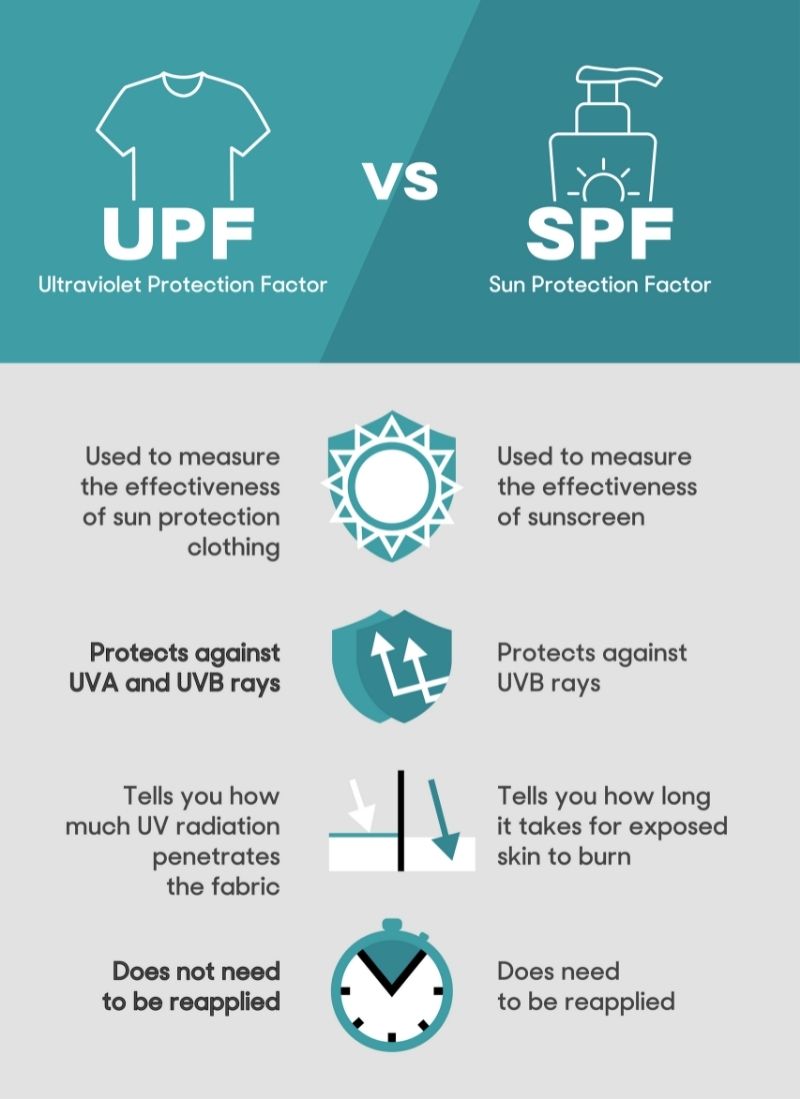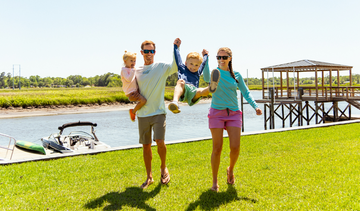If someone tries to sell you SPF clothing to protect your skin from the sun, run for the hills—or at least to another store. That’s because there is no such thing as SPF clothing. So, what's the difference between UPF and SPF? SPF is a designation used for sunscreen and lotions. UPF is the designation for clothing and fabrics.
Let’s take a deeper dive into the difference between UPF and SPF, along with other factors to ensure the sun-protective clothing you choose absolutely rocks.
UPF Explained
UPF stands for ultraviolet protection factor. It tells you how much UV radiation a fabric lets through to reach your skin. It covers both UVA rays and UVB rays.
- UVA rays: Rays that have a longer wavelength and are linked to skin aging
- UVB rays: Rays that have a shorter wavelength and are linked to skin burning
UPF clothing creates a barrier between the sun's UV rays and your skin. That means a UPF-rated sun protection neck gaiter helps protect your skin from sun damage as well as premature wrinkles. Nice.
The ratings range from excellent to meh.
- UPF 50 blocks 98% of the sun’s rays, which is excellent.
- UPF 30 blocks about 96% of the sun’s rays, which is still good—but not excellent.
- UPF 15 blocks roughly 93% of the sun’s rays, which is the lowest you can go on the UPF scale. So it gets the meh.
If you’re wondering how the numbers are calculated, you can always do the math.
UPF 50 allows 1/50th of the sun’s rays to get through
- 1/50 = 1 divided by 50 = 2%
- If 2% of the rays get through, 98% of the rays are blocked.
UPF 30 allows 1/30th of the sun’s rays to get through
- 1/30 = 1 divided by 30 = 3.3%
- If 3.3% of the rays get through, about 96% of the rays are blocked.
UPF 15 allows 1/15th of the sun’s rays to get through
- 1/15 = 1 divided by 15 = 6.6%
- If 6.6% of the rays get through, roughly 93% of the rays are blocked.
Yeah, we know. Math can start giving you a headache. In that case, skip all the calculations and just look for a UPF rating of 50 or above on your protective clothing.

SPF Explained
SPF stands for sun protection factor. It refers to the amount of time it takes for your skin to redden when exposed to UV rays. SPF only measures UVB rays, or those associated with skin burning.
SPF ratings have far less math involved than their UPF cousin. The number indicates how much longer you may be able to stay out in the sun before your skin begins to redden.
- SPF 15 is meant to protect 15 times longer
- SPF 30 is meant to protect 30 times longer
You get the idea. So if your skin normally burns within 20 minutes, SPF 15 is designed to protect you for 15 times longer. More math gets you: 15 x 20 = 300 minutes. Divide 300 minutes by 60 to calculate the number of hours.
In the above scenario, you could theoretically stay in the sun for five hours before you started to burn.
How to Choose UV Protective Clothing
The UPF rating is the first thing to look for when shopping for sun protection fishing shirts and other clothing. But it’s not the only thing that matters. You also want to pay attention to other factors that help take the clothing from good to absolutely awesome.
1. UPF 50+

True awesomeness begins with clothing rated 50+, the maximum sun-protection rating that provides the maximum protection for your skin. Heck, fabrics need at least a UPF 30 to get the Skin Cancer Foundation's Seal of Recommendation. That means don’t even bother with anything down in the UPF 15 range.
2. Cool Wicking Technology

Hot and bothered is not a good look. Neither is cold and dank. You want your camo long sleeve shirt and other outdoor apparel to adapt to hot or cold conditions to keep you cool and dry.
PURE-tech cool wicking technology does exactly that. It’s like your own personal body temperature regulator, releasing heat when it’s warm and trapping it in the cold. The UV-certified fabric also absorbs quickly and dries in a flash.
Best of all, PURE-tech is a permanent feature of the fabric. That means it lasts through every wash, game, hike, fishing trip or bocce ball tournament.
3. Odor-Resistant Technology

Fresh and crisp is a great look. And you’ll get it with your performance T-shirt and other sun-protection clothing if you look for something called M-Shield. This zinc-based, odor-resistant technology keeps fabrics fresh by defending against odor-causing bacteria.
Not only does M-Shield help boost your performance, but it also helps the fabric last longer.
4. Easy Care

Don’t you hate it when you find the perfect shirt—only to find it says: “Hand Wash Only.” We do, too. That’s why you want to look for sun gaiters, hoodies and eco-friendly shirts you can simply throw in the wash and be done.
Machine-washable items are a must, with a bonus of choosing to hang dry or tumble on low.
5. Protective Fabric
The best protective clothing is made from tightly woven, synthetic fabric. Loosely woven clothes with natural fibers do not provide as much protection from harmful rays.
6. Easy Care
Don’t you hate it when you find the perfect shirt—only to find it says: “Hand Wash Only.” We do, too. That’s why you want to look for sun gaiters, hoodies and eco-friendly shirts you can simply throw in the wash and be done.
Machine-washable items are a must, with a bonus of choosing to hang dry or tumble on low.
7. Multi-Season and Multi-Purpose Use

What if you got a sun gaiter you could only use in the summer for hiking? That would be annoying, right? The best UV gaiter is going to work in the summer for hiking, in the winter for skiing and in the fall and spring for doing whatever.
The same needs to hold true for any moisture-wicking long sleeve shirt, side-pocket leggings, or other sun-protection clothing you buy.
Make sure the UPF apparel you pick has the right technical properties to work on its own in summer and as warming and wicking layers during the colder months of the year. You also want sun protection clothing that will stand up to any activity you’re intending to give it.
Whether it’s swimming, boating, hiking, biking, fishing, skiing or climbing Mount Everest—you want sun-protection clothing that does it all. Hint: The selection at Vapor Apparel has you covered on all the above.

UPF vs SPF FAQ
What is the difference between SPF 50 and UPF 50?
A piece of clothing with UPF 50 allows around 1/50th of the sun's UV radiation to reach the skin. The SPF number tells you how long the sun's rays will take to redden your skin. With SPF 50 it would take you 50 times longer to burn than if you weren't wearing sunscreen.
Do you wear sunscreen under UPF clothing?
It's important to not rely on SPF alone to protect your skin because no single sun protection method works perfectly. Clothing is the most effective form of sun protection.
Does UPF prevent sunburn?
UPF clothing can protect your skin and decrease the risk of skin cancer and sunburn. It's important to note that not all fabrics and colors provide equal protection. Tightly woven, bright or dark colors, loose-fitting apparel provides the best UPF protection.
How long does UPF clothing last?
UPF clothing lasts approximately 30 to 40 washes; with regular use, the clothing should last about one year.
How do you care for UPF clothing?
- Wash or rinse in cold water
- Hand wash or use gentle/delicate cycle
- Use a mild detergent
- Do not tumble dry
- Keep out of direct sunlight when drying
Do you need to wear UPF year-round?
Yes. UV light can penetrate through clouds, smog, glass and are present all throughout the year. Skin Care is important year round as skin cancer is the most common cancer in the United States and worldwide. In fact, having 5 or more sunburns doubles your risk for melanoma.





